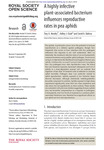Please use this identifier to cite or link to this item:
http://lib.hpu.edu.vn/handle/123456789/23547Full metadata record
| DC Field | Value | Language |
|---|---|---|
| dc.contributor.author | Hendry, Tory A. | en_US |
| dc.contributor.author | Baltrus, David A. | en_US |
| dc.contributor.author | Clark, Kelley J. | en_US |
| dc.date.accessioned | 2016-10-11T05:37:12Z | |
| dc.date.available | 2016-10-11T05:37:12Z | |
| dc.date.issued | 2016 | en_US |
| dc.identifier.other | HPU4160658 | en_US |
| dc.identifier.uri | https://lib.hpu.edu.vn/handle/123456789/23547 | en_US |
| dc.description.abstract | Pea aphids, A cyrthosiphon pisum, have the potential to increase reproduction as a defence against pathogens, though how frequently this occurs or how infection with live pathogens influences this response is not well understood. Here we determine the minimum infective dose of an environmentally common bacterium and possible aphid pathogen,Pseudomonas syringae, to determine the likelihood of pathogenic effects to pea aphids. Additionally, we usedP. syringaeinfection to investigate how live pathogens may alter reproductive rates. We found that oral bacterial exposure decreased subsequent survival of aphids in a dose-dependent manner and we estimate that ingestion of less than 10 bacterial cells is sufficient to increase aphid mortality. | en_US |
| dc.format.extent | 10 p. | en_US |
| dc.format.mimetype | application/pdf | en_US |
| dc.language.iso | en | en_US |
| dc.subject | Biology | en_US |
| dc.subject | Ecology | en_US |
| dc.subject | Evolution | en_US |
| dc.subject | Microbiology | en_US |
| dc.subject | Acyrthosiphon pisum | en_US |
| dc.subject | Pseudomonas syringae | en_US |
| dc.subject | Fecundity compensatio | en_US |
| dc.title | A highly infective plant-associated bacterium influences reproductive rates in pea aphids | en_US |
| dc.type | Article | en_US |
| dc.size | 478KB | en_US |
| dc.department | Education | en_US |
| Appears in Collections: | Education | |
Files in This Item:
| File | Description | Size | Format | |
|---|---|---|---|---|
| 0541_Ahighlyinfective.pdf Restricted Access | 478.73 kB | Adobe PDF |  View/Open Request a copy |
Items in DSpace are protected by copyright, with all rights reserved, unless otherwise indicated.
